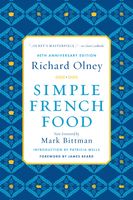Advertisement
Chopping
Appears in
Published 1974
Chopping means cutting cleanly into minuscule fragments. Grinding, crushing, and pureeing, for all their apparent similarity, physically change the structure of a material, releasing the juices that are held within it. The particles of a correctly chopped article remain unbruised and intact, their primitive structure unaltered, their juices and, in the case of herbs, their perfumes retained. Machines and dull knives bruise, wound, bleed . . . Only with sharp knives and an absolutely plane and smooth wooden surface can one chop without damage. It is a gentle and a rational act; violence will get you nowhere. Use a so-called “chef’s knife,” the blade of which is wide enough to prevent your knuckles from rapping against the chopping board. First slice thinly, if the material calls for it, fingertips of the guiding hand turned inward out of reach of the blade, knuckle against the side of the blade to guide it. Cross-slice, then chop, keeping the fulcrum point of the knife always in contact with the board by a light pressure from the flat of your non-chopping hand, an inch or two back from the point of the knife blade. An excess of enthusiasm can only lead to an erratic result and, very disagreeably, to a certain amount of chopped chopping board incorporated into the product. Have at least three or four good sharp knives and always keep a sharpening steel within reach. There are very good stainless steel knives on the market today; they sharpen well, are easy to care for, and will not blacken artichokes and certain other vegetables as will carbon knives.


